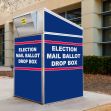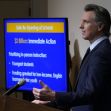Way back in 1911, California voters approved a Constitutional amendment that allows them to recall and remove their elected officials and State Supreme Court justices. Voters have attempted this 179 times, but only six have been successful. The latest ballot measure, targeting Gov. Gavin Newsom for the seventh time since 2019, failed again. But one man who felt his constitutional rights were violated during the most recent unsuccessful recall attempt raised some new questions. He challenged the constitutionality of the whole election recall process. He did not succeed.
A three-judge panel of the United States Court of Appeals for the Ninth Circuit unanimously affirmed the opinion of the United States District Court for the Central District of California on November 29. Justice Paul J. Watford wrote the opinion, which agreed that plaintiff-appellant A.W. Clark failed to state a valid claim of action in his suit against California Secretary of State Shirley Weaver.
Clark’s claim raised two federal constitutional challenges to the state’s recall procedure. Justice Watford’s opinion began with a description of how it works. He explained the two-step ballot-question process that voters use when they vote for or against a recall. First, they vote “yes” or “no” on whether the elected official, Newsom in this case, should be removed from office “upon the qualification of his successor.”
Second, voters are asked to select a successor from a list of candidates who qualified to be on the ballot. Article 15 (c) of the California Constitution, which Watford calls “the key provision at issue” in this case, forbids any recalled official to succeed him or herself. If the recall is successful, the person who receives the most votes, even by a one-vote margin, fills the now-vacant post.
In August 2021, Clark filed the appropriate papers to halt the recall election. Not only did he want to vote against recalling Newson on the first question, but he also wanted to vote for Newsom to succeed himself on the second question. His theory was that California’s recall process violated his Fourteenth Amendment rights in two ways. First, it denied him “an equally weighted vote” as required by the Constitution’s one-person, one vote principle. Next, it denied him the right to vote for his candidate of choice on Question two.
The District Court denied his request to enjoin the election for multiple reasons. Primary among them was that he was unlikely to succeed. He appealed and the Ninth Circuit denied his emergency request for injunctive relief. The election was held, and over 60% of California voters voted “no” on recall Question one.
Since the election was over, it would be logical to assume that Clark’s challenge was moot after the election because he originally sought only prospective, not retrospective relief. But Clark amended his complaint to add a request for nominal damages, which Watford “assumed” were to be collected from Secretary of State Weber. The opinion then agreed that Clark did “adequately allege a completed injury.” Nominal damages, he said, “would redress that injury.”
Weber, however, moved to dismiss all of Clark’s claims, and the District Court granted her motion for the same reasons it had used in its previous decision that denied Clark’s preliminary injunction. Clark appealed again.
Watford, who showed no patience in his latest ruling in this case, went on to state that both of Clark’s federal constitutional challenges were “without merit.” In his first federal challenge, Clark was not denied his “one-person, one-vote” right because all voters could mark their ballots for both Question 1 and 2. True, they could not vote for Newsom on Question 2, but this did not “dilute” the vote as Clark claimed.
Instead, the opinion clarifies that “California’s recall procedure in effect permits two separate elections to be conducted simultaneously.” The first decides whether the official is recalled, while the second determines the successor. In both elections, Watford said, “Every vote is weighted equally…Equal protection is not violated simply because the two elections require different vote thresholds….”
Clark’s second constitutional challenge was based on an alleged violation of his right to vote for his candidate of choice since Newsom was not listed on Question 2. This argument also failed. Citing a parallel to the constitutionality of term limits, the opinion said that the restricted list made “no distinction on the basis of any protected expression, party affiliation, or inherently arbitrary factors such as race, religion, or gender.” In fact, Watford said, the list is neutral and has had a “relatively minor impact on voter’s ability to make themselves heard.”
Watford then declined to address Clark’s additional argument based on California law.
The Los Angeles Times reported that the unsuccessful attempt to unseat Gov. Gavin Newsom cost state and local government more than $200 million. Secretary of State Weber said, “This was a substantial cost to taxpayers and a significant disruption to governing the state…That price tag confirms this it is necessary to revisit the recall process and to pursue effective reforms.”
Weber did not add in the cost of Clark’s lawsuits to taxpayers: the original request for an injunction, the appeal, the district court’s costs, the amended appeal, and the Ninth Circuit’s personnel and administrative expenditures for hearing his appeals twice.
Perhaps it is time to not only pursue effective reforms to the recall process but also pursue ways to reform the way frivolous or meritless lawsuits associated with them are adjudicated as well.






